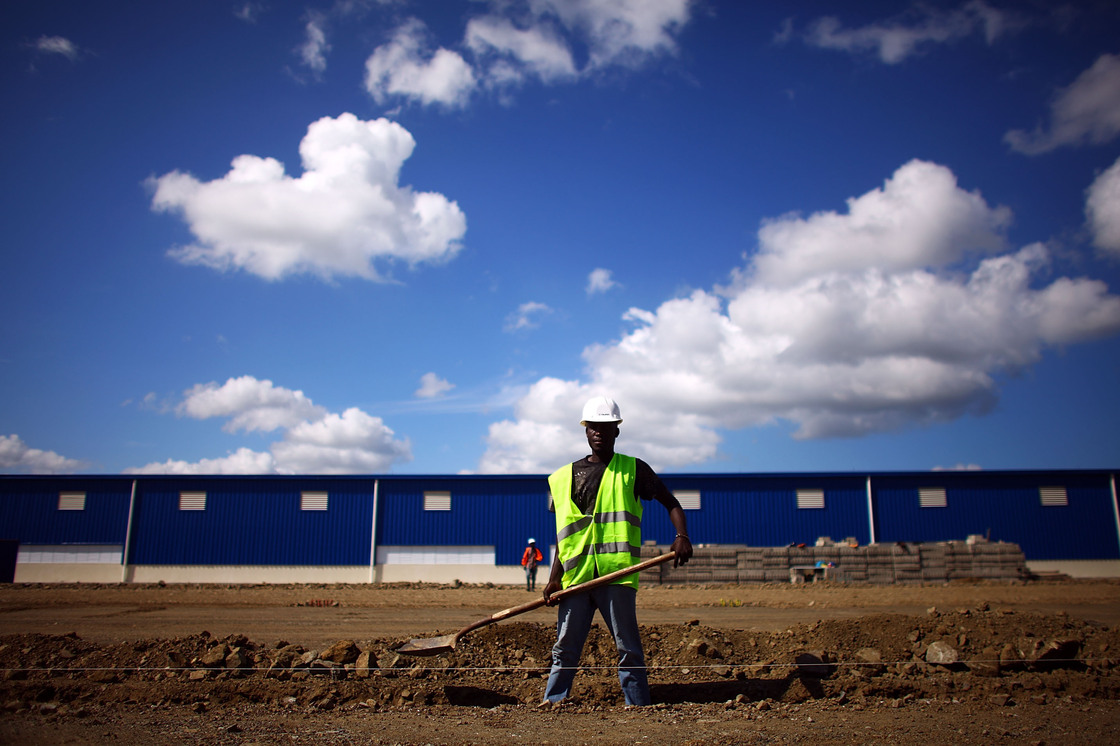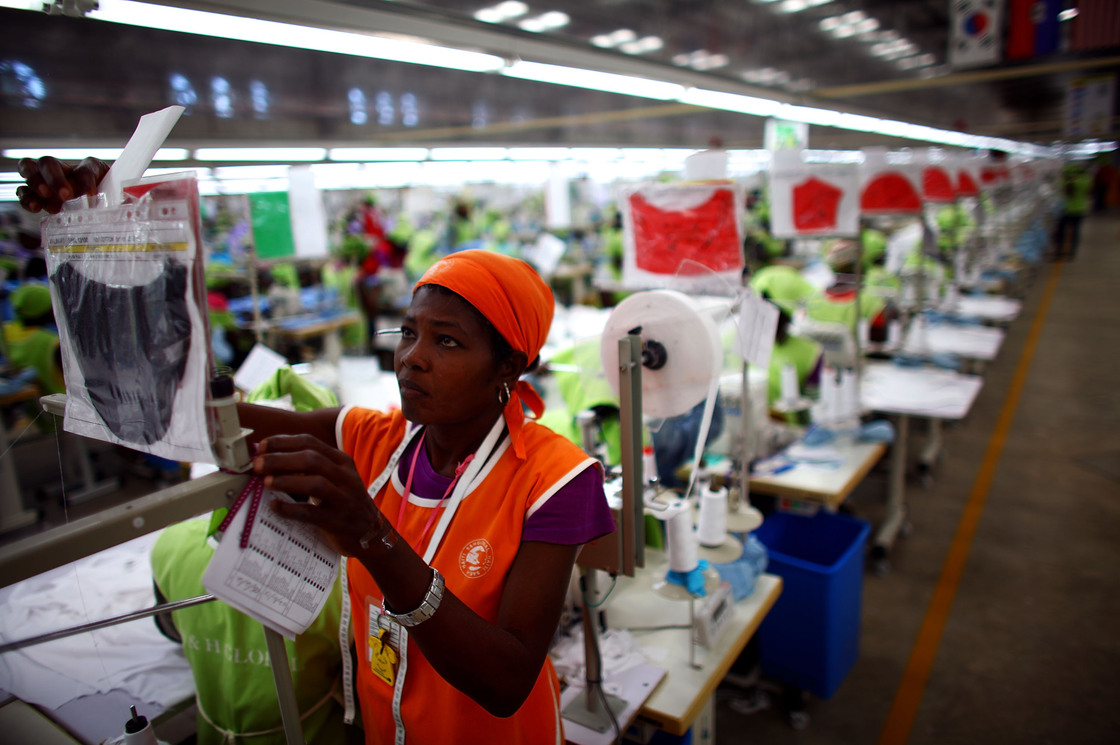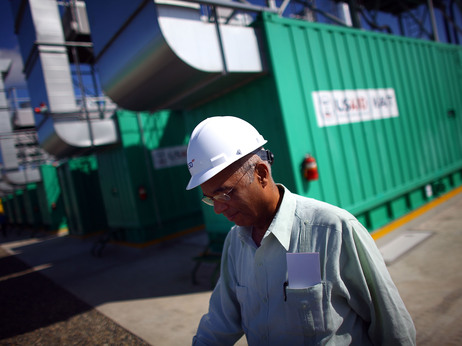-
 David Gilkey/NPR
David Gilkey/NPR -
 David Gilkey/NPR
David Gilkey/NPR -
 David Gilkey/NPR
David Gilkey/NPR -
 David Gilkey/NPR
David Gilkey/NPR -
 David Gilkey/NPR
David Gilkey/NPR -
 David Gilkey/NPR
David Gilkey/NPR -
 David Gilkey/NPR
David Gilkey/NPR -
 David Gilkey/NPR
David Gilkey/NPR
1 of 8
Three years after the devastating Port-au-Prince earthquake, one of the largest international relief projects in Haiti isn’t anywhere near where the quake hit. It’s an industrial park on the north coast halfway between Cap-Haitien and the border with the Dominican Republic.
Aid agencies are pouring millions of dollars into the project to encourage people to move out of the overcrowded capital and create jobs. Critics, however, say the jobs don’t pay enough to lift people out of poverty.
The Caracol Industrial Park is one of the most tangible developments to come out of the billions of dollars in post-earthquake aid to Haiti.
The sprawling 600-acre compound sits in what used to be small vegetable plots and scrubby pastures. It officially opened late last year, but much of the park is still under construction.
Georges Sassine, the head the Haitian government agency that oversees industrial parks, says the goal is for Caracol to directly hire 60,000 people, spurring the growth of tens of thousands of other jobs outside the park.
Appeal To Manufacturers
Sassine has been in Haiti’s garment manufacturing business for decades and says he’s confident that international manufacturers will be eager to lease space in the facility.
“Why do they want to come here?” he asks rhetorically. “Economics, the availability of labor, cost of labor, access to the U.S. market. We are very close to the U.S., plus you are not paying duty. So it’s win-win-win.”
Labor all across Haiti is plentiful and cheap. Even with only a fraction of the industrial park up and running, dozens of people are lined up outside the gates hoping to find work. The minimum wage in Haiti is $5 a day. And thanks to legislation passed by the U.S. Congress after the earthquake, most Haitian textiles can now enter the U.S. duty-free.
The anchor tenant at the park is the Korean clothing giant SAE-A.
Inside a brightly lit new factory, women in lime-green smocks and matching headscarves sit in long rows. Each row produces a different color T-shirt. The production lines look like long industrial stripes of purple, black, green and white.
The shirts labeled “Made in Haiti” will sell for $7 apiece at Wal-Mart stores in the United States.
SAE-A currently has just over a thousand people working at Caracol but plans to hire thousands more. Sherwin-Williams recently opened a paint production facility across the street. Other blue-metal buildings are going up across the park.
Georges Sassine heads the Haitian government agency that oversees the Carcacol Industrial Park. He says the low cost and availability of labor in Haiti, the proximity to U.S. markets, and favorable bilateral trade measures make Caracol highly attractive to foreign manufacturers.
David Gilkey/NPR
Electricity at the park comes from a 10-megawatt power plant installed by the U.S. Agency for International Development, or USAID. Sassine says the generators provide electricity not just to the park but also to the surrounding communities, which never had power before.
“The whole idea is not only to create jobs, but to see if we can create better living conditions for everybody around,” Sassine says. “That’s what it’s all about.”
Many local residents shrug off the arrival of electricity, however, saying they can’t afford to pay for it.
Remote By Design
Caracol feels as if it’s in the middle of nowhere, and that’s exactly what the project’s planners intended.
One of the reasons the 2010 earthquake was so deadly is that over the past four decades, hundreds of thousands of Haitians migrated to Port-au-Prince, Haiti’s capital, looking for work. When the quake hit, many of them were packed into overcrowded, poorly built cinder-block buildings.
Gilles Damais, the head of the Inter-American Development Bank’s Haiti office, says Caracol is a critical element of efforts to decentralize Haiti away from the capital.
“Port-au-Prince was built for more or less 250,000 people,” Damais says. “And now we have nearly 3 million in the metropolitan area. It’s unsustainable. It’s impossible to rebuild such a monster.”
The IDB has poured more than $130 million into Caracol and expects to spend millions more on the project in 2013.
In addition to the park, the IDB and USAID are constructing thousands of new houses nearby. The Dominican government, as its primary earthquake relief gesture to Haiti, built a new public university in the area.
The hope from an economist’s point of view is that all of this new activity will spur the growth of other businesses and that a rising tide will lift all boats.
Limited Success Previously
But Haiti has had clothing factories for decades, and it’s still the poorest country in the hemisphere. The notorious slum of Cite Soleil began as housing for garment workers in Port-au-Prince’s export zone.
Pierre Telemaque, who has worked at textile plants in the capital for the past decade, says these jobs don’t offer a path out of poverty. A typical salary of $5 to $7 a day, he says, isn’t enough to live on.
Transportation alone costs approximately $1.50, Telemaque says. Then if the worker buys something to eat for breakfast and something at lunch, she ends up taking home just a dollar or two a day, he says, adding that most workers can’t even afford to rent a small room.
But in a country where 70 percent of the population lacks regular employment, Sassine of the Caracol Industrial Park argues that textile jobs at least provide a steady income.
“Wages are never enough to lift people out of poverty, especially in a poor country,” Sassine says.
Pointing toward the roughly 1,000 women who’ve recently been hired at the SAE-A T-shirt plant, Sassine says these women are now bringing money into the entire community.
“Today they are getting 200 gourdes a day,” he notes. “That’s 200,000 gourdes that comes in every day into this area which never saw 200,000 gourdes a year.”
That amount — 200 Haitian gourdes — is the minimum daily wage allowed by law. It’s worth roughly $5. Sassine says it may not be much, but at least it improves workers’ living standards — and it’s better than no job at all.
___________________________________________________________
COMMENT: HAITIAN-TRUTH.ORG
With all due respect, I thought we did away with slavery a century ago.
$5.00 US per day is not enough to cope with anything, now that the cost of primary food items has gone up over 50% in the past few months.
This comes out to about $0.69 per hour.
I am normally a right wing fascist pig, but this is beyond the limits!!
I am also anti-union, but we need someone on a White Horse to unionize this place and force some fairness.
Korean clothing giant SAE-A has already been thrown out of several countries for ill-treatment of employees.
There are cynics who suggest that Bill Clinton benefited financially from this big fiasco.
If Haiti is to survive, let alone progress, there must be higher wages. Otherwise, we just perpetuate the present, impossible situation in which families do not have anywhere to live, enough to eat…or money to send kids to school.
No one has mentioned where the 60,000 workers are going to live. The area around the slave camp has no housing available.
And this place will draw business from the SONAPI industrial project, in Port-au-Prince, because of lower wages required.
This is not going to improve things, it just shifts the problem from one pocket to another.
Georges Sassine is just another one of those guys who has benefited from cheap labour with little attention to the social effects.

Haiti’s business and political leaders, as well as international donors have always only been interested in superficial progress. Let’s put up a shiny factory here, or a fancy industrial park there with little to no concern for the more substantive needs of the people, namely paying them a living wage.
So, what does that even mean?
A living wage is “a theoretical wage level that allows the earner to afford adequate shelter, food and the other necessities of life. The living wage should be substantial enough to ensure that no more than 30% of it needs to be spent on housing. The goal of the living wage is to allow employees to earn enough income for a satisfactory standard of living.”
A living wage is different from the minimum wage, which is typically mandated by federal law. In Haiti’s case, the minimum wage fails to meet the basic living wage needs of the average Haitian.
The blame in this case should not be placed on Georges Sassine, Sae-A or the business community. They are operating within the wage parameters set by the Haitian government. While I agree with your comment that Haiti is in need of a strong union to enforce a living wage, it’s a delicate balancing act which goes contrary to attracting foreign investment. Investment which we are in dire need of.
As a result of our dismal political and investment history, we are playing catch-up with the rest of the world. The Haitian population has been forced to suffer from the moment we were shipped from West Africa, at the hands of the slave master, up until today, at the hands of our own politicians, wealthy elite and international community (read French and Americans). There is no doubt that the the suffering will continue for years to come.
A small measure of our future success however, will be in our ability to abate some of that suffering by creating opportunities for the people to work, feed, shelter and educate their children. Conditions will not be ideal but we have to start somewhere and the Parc Industriel in the North is as good a start as any.
As Haitians are wont to say, “Le travail c’est la liberte.” Let’s continue to work toward that freedom.